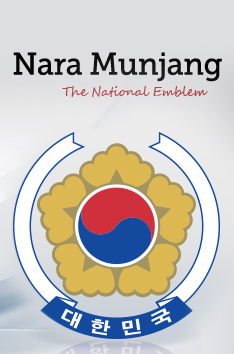The National Emblem - Nara Munjang

Significance
In general, emblems were adopted in western countries to symbolize the genealogical records and authority of a clan, organization, or the state. The national emblem of Korea is called Gukga Munjang or Gukjang. The design is based on the motifs of the Taegeukgi flag and the Mugunghwa flower, which are national symbols. The taegeuk motif is surrounded by five mugunghwa petals, and the entire design is encircled by a ribbon with the letters ‘대한민국 (Republic of Korea).’
Usage
Based on the Regulations on the National Emblem formulated on
December 10, 1963, the national emblem is used as a state symbol on
major documents sent to foreign institutions, on medals and other
decorations, Presidential commendations, and signage on diplomatic
missions abroad.
The emblem is designed in the form of a badge or a brass die.
If necessary, the size can be scaled up or down depending on the usage.
Usage (Article 3, Regulations on the National Emblem)
- Official documents sent abroad, international organizations or foreign institutions stationed in Korea
- Certificates of appointment for 1st-grade or higher grade government officials
- Medals, certificates of decoration, and Presidential commendations
- Public official ID cards
- Graduation certificates or diplomas issued by national or public universities
- Vessels or aircraft owned by the government
- Diplomatic missions overseas
- Currency
- Documents, facilities, or goods on which the use of the national emblem is deemed necessary by the head of a ministry or agency

